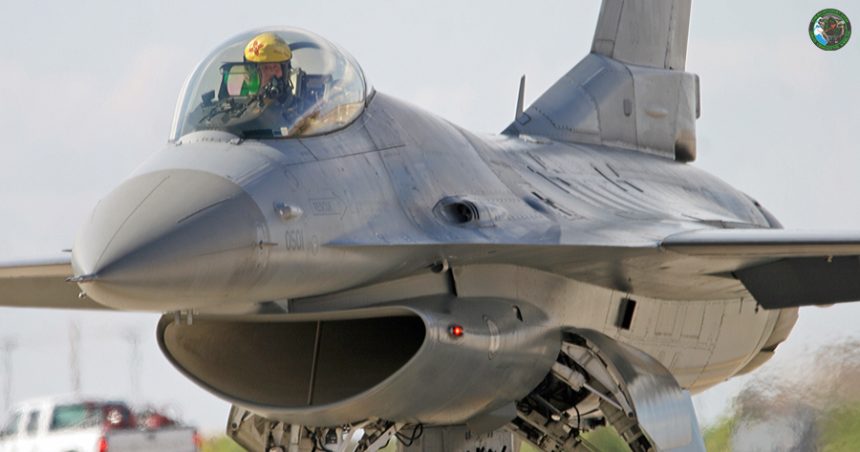Amid Pilot Shortages, F-16 Pilots Train for Real-World Combat at Holloman AFB.
It’s hot as hell out here.
Most of the other reporters have given up. They’re back in the air-conditioned squadron room. Between screaming jet noise, blaring sun, hotplate pavement and a long day that started early this morning with briefings and a catered media tour in shaded hangers it’s gotten real now. And real means hot, loud and uncomfortable.
The U.S. Air Force invited TheAviationist.com to Holloman AFB ten miles outside Alamogordo, New Mexico to showcase the Light Attack Demo and, more importantly, the new evaluation process that goes with it.
But Holloman AFB is a long way from anywhere in the middle of nowhere so our Air Force media staff crams as many story opportunities for visiting journalists into the day as possible. This is the last story of our day, F-16 operations at Holloman AFB. As it turns out, it’s the best story.
Holloman AFB is home to the 54th Fighter Group, the Jedi academy for the best F-16 combat pilots on earth. And while certain Israeli F-16 units may argue that superlative, the live-fire, gun smoke combat experience of the fighter pilots who teach here hangs over the base like the bright white dust blown in from the White Sands Missile Range just to the south. This is where the meat-eaters train for today’s air war.
From the moment you walk into the Group building things feel serious. Staff is moving from office to office quickly. There is a lot of foot traffic. Flight-suited pilots keep right in well-traveled hallways coming from de-brief or going to briefings. The floor of this building rumbles with the operational tempo. Missions are coming in, others being planned to go out.
The tearing sound of two F-16’s leaping into the air on full afterburner vibrates the doors on the building. Since Holloman is miles away from the nearest town, Alamogordo, there aren’t any worries about noise abatement here. Pilots take-off on training sorties the way they would for combat. And the desert rattles under angry jet thunder.
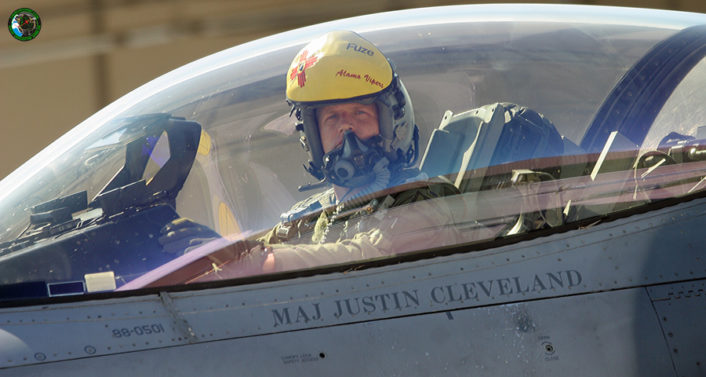
It’s unlikely the people who live in Alamogordo would complain about jet noise anyway. The sleepy desert town hangs by its economic fingernails to the outskirts of the base. No base, no Alamogordo. Menus in the local breakfast dives have photos of F-22s on them, not pancakes. The main drag is a succession of fast food places, pawn shops and motels that rely on military revenue for survival. If the base can grow its cadre of enlisted personnel, instructors and student pilots, the town can grow too.
The Air Force faces a problem though, a shortage of fighter pilots and instructors. An Air Force Lt. Col. whose call sign is “Burn Clapper” has been at Holloman since November of 2014 and in command of the 54th Fighter Group since May. During our briefing he tells us, “I’m supposed to have 24 instructor pilots in my squadron, and I have 13 now.”
When I ask Burn Clapper about the reasons for the fighter pilot shortage he tells me, “A few years back, there was a time when we had as many fighter pilots as we needed. We only produced guys coming in for as many guys who were leaving – at the rate that they were leaving then. We only made fighter pilots for who was leaving then, maybe about 400 a year – that’s a guess.”
“Our pilots graduate now with a 10-year commitment. They have been back and forth to combat over the last five years. The economy is good now. Now they have options.”
But the demand for fighter pilots has increased significantly, and the Air Force is responding. Burn Clapper tells us, “The next step is to stand up the 8th fighter squadron. It may become a super squadron, with 40 jets instead of 24 jets PAA (Primary Assigned Aircraft) under one commander. The advantage of a super squadron is you can pool resources to make it easier. We can all use the same scheduler, we can use the same admin side…”
The pilots and instructors they do have here at Holloman are incredibly busy. “The day to day routine for our fighter pilots starts late Friday, Saturday and Sunday to prep for flying on Monday. They fly Monday, they debrief Monday,” Burn Clapper tells us. “They then brief or prep for [flying on] Tuesday, they never get any time off to do their office job. They are busy flying.”
USAF Brigadier General Brook J. Leonard, Commander of the 56th Fighter Wing (parent unit to the 54th Fighter Group), is sitting with me on the hot bus ride out to the even hotter flight line. If Brig. Gen. Leonard showed up to a casting call for a movie about fighter pilots they wouldn’t pick him because he looks too much like a fighter pilot. Tall as a monument, chiseled features, he doesn’t wear sunglasses in the blaring glare of the White Sands desert. You get a sense Brig. Gen. Leonard could stare down the sun. I wager the top of his crew cut was leveled using an attitude indicator from an F-16.
Our bus yields to a trio of F-16’s taxiing fast on their way back from a training sortie to their aircraft shelters. Airmen check the tires of our bus for “FOD”, debris that could come off and be sucked into a jet engine. They give us one quick look-over for security, the fourth time today we’ve been surreptitiously screened for security. This isn’t a weekend airshow. This is the real world.
“What is the orange Sidewinder on the rail of that F-16?” I ask Brig. Gen. Leonard as an F-16 taxis quickly in front of us.
“We use those for OPFOR identification – red air. It’s so they can tell the good guys from the bad in a close-in engagement.” The General tells me.
I ponder the General’s answer for a minute; F-16’s dogfighting over the desert at nearly a thousand miles per hour are fighting so close to each other they can identify friend from foe by a single red missile on a rail under one of their wings.
“Are they fighting that close together Sir?” I ask the General. He shoots me a look, “Well… yeah.”
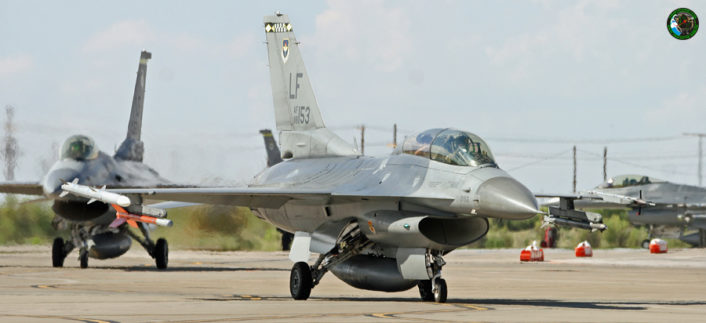
The pilots in the F-16 cockpits taxing back in from a training mission aren’t waving. They look haggard. Sweaty, unsmiling, oxygen mask unclipped and dangling from one side of their helmet. Their eyes are clamped down in an exhausted squint. Air combat is physically exhausting and mentally draining. The pilots are crushed under their own accumulating body weight as they cross swords at high G’s. They piss their pants in “piddle packs” and get increasingly dehydrated with little time to drink during training engagements. The paint around some of the F-16s M61A1 Vulcan 6-barreled 20mm cannon is blackened with soot from gunfighting. Mid-air collision while training is a constant threat. This is about as far from the creased uniforms and synchronized airshow dance moves of the Thunderbirds as you can get. This is rehearsal for the real world of air combat.
While the rest of the air force is still developing BVR (Beyond Visual Range) doctrine for F-35s over the test ranges north of here Brig. Gen. Leonard’s men are likely the last of the great dogfighters. They aren’t training for a Beyond Visual Range engagement, they are honing the mentally demanding and physically grueling skills needed for a knife fight in a phone booth at Mach 1.
This is the air war we have fought – and won – a couple of times with the Syrians, years ago with the Iraqis, and may fight again with the North Koreans. This is not training for some conceptual war being argued in white papers, this is readiness for air combat today. Holloman’s F-16 instructors put the razor edge on the pointy end of our air warfare spear.
Out on the flightline our media bus stops. The press liaison ushers what reporters remain into an aircraft shelter with an F-16. Brig. Gen. Leonard briefs us on the mission going on around us.
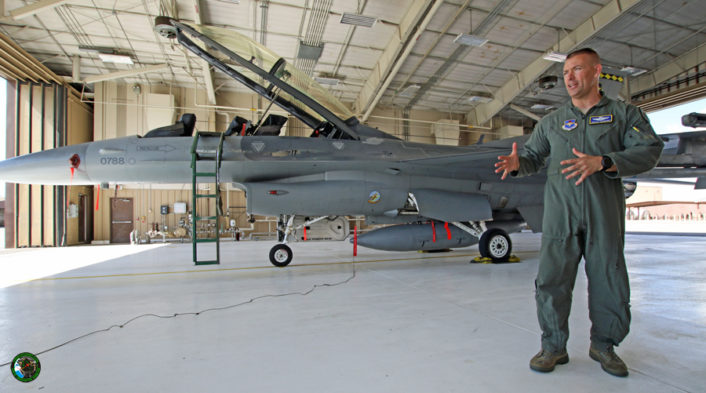
He introduces a man dressed in a crisp blacked-out flight suit wearing matte black Oakley sunglasses and a nearly as precise crew cut as the Brigadier himself.
“SSgt. Christopher Macias is a Dedicated Crew Chief for the F-16 to the 54th Fighter Group.” Brig. Gen. Leonard tells us. “He knows more about the jet than any of us.”
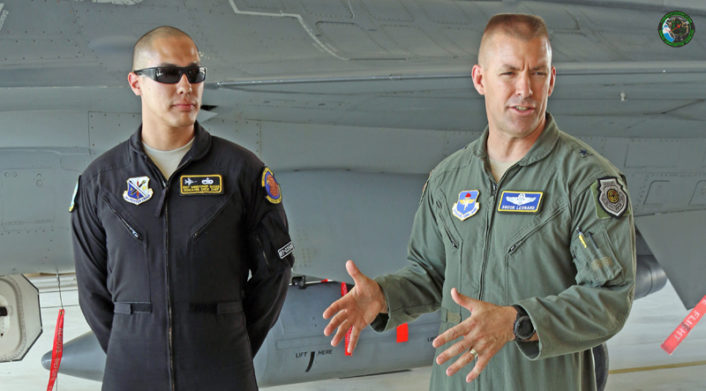
An enlisted man in the U.S. Air Force, SSgt. Macias is as razor-cut squared away as the Brigadier General and the other pilots we’ve met. Macias manages one of the maintenance crews who keep these well-used F-16’s flying. And while some of the aircraft appear weathered and flown hard, they are also spotlessly clean and in a high state of readiness. Huge glossy black rolling tool cases are kept shiny in the aircraft shelters on spotless floors. Tools inside are meticulously arranged. It’s clear the men like Macias who keep these aircraft flying have a deep affection and dedication to their jobs, exactly like the pilots.
I am the last reporter to board the media bus headed back to the unit office building. Our Air Force media liaison is trying to usher me back on so we can get to the briefing room and the air conditioning. Most of us have sweated through our clothing, but this is too good not to take in for just a few more seconds. More jets taxi from the end of the runway threshold. The tightly scheduled dance of deadly aerial combat training doesn’t wait for reporters. But I want to feel the concrete vibrate with the sound of operational jet noise, and feel what it’s like to walk in footsteps of one of the only real-world Jedi warriors for a just few more seconds.

